
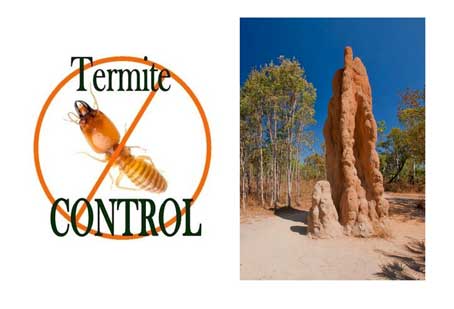
Did you know that sub-terranean termites can build upto 40 feet high mounds (termite colony). That is like a typical four-storeyed building.
Naturally termites are not a pest and their recycling of wood and other plant matter is of considerable ecological importance. It is only when they get into our house and start damaging its structure and wood; we consider them to be a pest.
Termites are sometimes called "white ants", though they are not closely related to true ants. Two of the major types of termites are Drywood termites and Sub -terranean termites.

Drywood termites live in dry, undecayed wood like limbs of trees, utility poles, posts, and lumber. Dry wood termites termites do not require a lot of moisture which makes them live in dry places. They do not require constant contact with the soil for their survival like it's Sub-terranean Cousin.
In a tropical country like India Sub-terranean termites are of more significance as they cause extensive damage. Subterranean termites are social insects which live in colonies in the ground. They build vertical tunnels that look like mud tubes (known as shelter tubes) above ground level in the search of food. Basically any sort of wood can tempt Termites. Wood is made up of Cellulosic material which is the favorite food of Sub-terranean termites. Termites can also damage material of organic origin with cellulosic base such as paper, cardboard, fabric, furniture, etc. However Sub terranean termites are known for their voracious tendencies and can damage even non-cellulosic substances also in search of the food and shelter.
Because subterranean termites will die if exposed to air for an extended period of time, therefore they need constant moisture source for their survival. The mud tunnels provide protection from the open air and direct sunlight, allowing workers to forage for the food. Subterranean termites can form runways in the form of tunnels through cracks in concrete. Therefore even RCC structures are not exempt from these termites.
We are specialist in two types of Termite Pest Control services: (i.e White ants treatment)
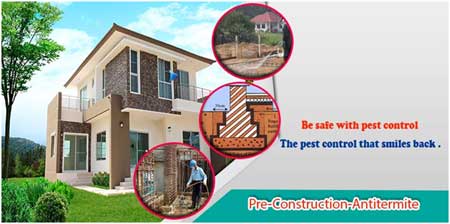
If you are planning to build a house or develop your property for building your office, termite control is the first thing you should think of. We use highly professional and advanced techniques for treating the termite infestation problem. Direct liquid treatments are applied to the outside, inside and also in the foundation to eliminate the termites completely. Direct injection of liquid pesticide (termiticide) in areas like the foundation, within the foundation walls and also areas under the concrete slabs is part of our specialized termite control treatment plan.
THIS TREATMENT IS CARRIED OUT AS PER THE SPECIFICATION OF IS 6313 PART II, 1981 AND THE AMENDMENT LAY DOWN BY THE INDIAN STANDARD BUREAU AFTERWARD. THE MAIN POINTS OF THIS TREATMENT ARE AS UNDER:
TREATMENT FOR FOUNDATIONS - THE FOUNDATION SHALL BE TREATED WITH CHEMICAL EMULSION AT THE RATE OF 5 LITER PER SQUARE METER OF THE SURFACE. TREATMENT WILL BE DONE BY SPRAYER AS PER SPECIFIED PUMP . HOLES UP TO 150 MM DEEP AT 150 MM CENTERS BOTH WAYS MAY BE MADE WITH 12 MM DIAMETER MILD STEEL ROD ON THE SURFACE TO FACILITATE SATURATION OF THE SOIL WITH THE CHEMICAL EMULSION.
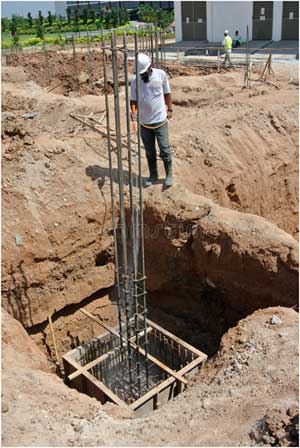
Treatment of Top surface of Plinth Filling - The top surface of the consolidated earth within plinth wall, shall be treated with chemical emulsion at the rate of 5 liter per square meter of the surface before the sand-bed or sub-grade is laid. If the filled earth been well rammed and the surface does not allow the emulsion to seep through, holes up to 50 to 75 mm deep at 150 mm centers both ways may be made with 12 mm diameter mild steel rod on the surface to facilitate saturation of the soil with the chemical emulsion
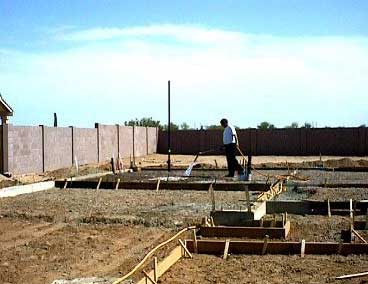
Treatment at Junction of the wall and Floor - Special care shall be taken to establish continuity of the chemical barrier on inner wall surface from ground level up to the level of the filled earth surface. To achieve this, a small channel 30x30 mm shall be made at all the junction of wall and columns with the floor (before laying the sub grade) and rod holes made in the channel up to the ground level 150 mm apart and the iron rod moved backward and forward to breakup the earth and chemical emulsion poured along the channel at the rate of 7.5 liter per square meter of vertical wall and column surface so as to soak the soil right to the bottom. The soil should be tamped back into place after this operation.
Treatment of soil along External Perimeter of Building - Special care shall be taken to establish continuity of the chemical barrier on inner wall surface from ground level up to the level of the filled earth surface. To achieve this, a small channel 30x30 mm shall be made at all the junction of wall and columns with the floor (before laying the sub grade) and rod holes made in the channel up to the ground level 150 mm apart and the iron rod moved backward and forward to breakup the earth and chemical emulsion poured along the channel at the rate of 7.5 liter per square meter of vertical wall and column surface so as to soak the soil right to the bottom. The soil should be tamped back into place after this operation.
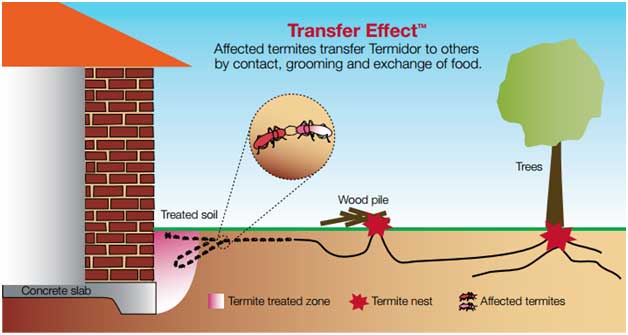
Service guarantee: The entire execution of Pre construction anti termite treatments backed up the service guarantee of TEN YEARS form the date of execution. If during the said period re infestation of subterranean termites occurs the same shall be treated free of cost basis.
Service Guarantee shall not be furnished for the partially treated area.
NOTE: We provide termite control services in Uttar Pradesh and Madhya Pradesh etc. We have earned the reputation as one of the best Anti termite treatment company in North India for the last 20years.
For more information on Pre Construction anti Termites Treatment or our expert's advice kindly dial +91-9415253209, 9452788122
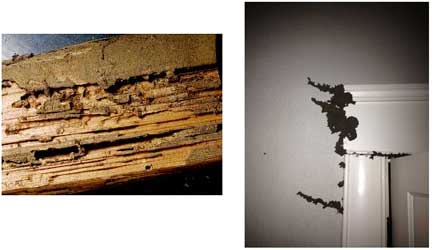
Termites, also commonly known as white ants, destroy valuable property, documents, furniture and furnishing; anything that contains cellulose. They do this silently and swiftly, even before you become aware of the damage done. Termites infest and breed underground, in the soil. They crawl up through the minute cracks and crevices in the foundation and the walls of your building
As they march forward, they build mud channels to provide themselves with darkness and higher humidity, which they require to survive. When you notice such marks on your walls it is an indication that your house is under attack from termites. We have provided Termite control services to more than 1,50,000 buildings in U.P.and M.P. more than any other pest control company. We have two services for Termite Control
On the basis of their habitats, termites or white ants are divided into two well defined groups.
1- Subterranean termites : or ground nesting termite species build nests under the ground and make their way up to the super structure through voids in masonry in search of food i.e. cellulose present in wood, paper, textiles etc.
2- Non-Subterranean termites: are winged species living on cellulose, basic nutrient present in wood, paper, textiles etc. without soil contact.
These are two different entities requiring separate treatments.
Subterranean Termite infestation : Post construction Anti-termite treatment relates to Structural Pest Control. The Queen termite resides 1 to 4 meters deep below the ground and has a reproductive’s that come out are of a very high social order comprising of worker and soldier termites. The blind worker termites guarded by soldier termites are ubiquitous creatures and stealthily make their way up to the super- structure in search of cellulose found in wood, paper, textiles etc. through voids in masonry. They require moisture and darkness to sustain their life that is why they need access to ground at all the times. The worker feed the reproductive’s, soldiers, winged adults and nymphs. One of the habits of the termites which is of interest is the grooming of their own bodies and the bodies of the nest mates by licking . This grooming habit is associated with their eagerness to obtain the glandular secretions that are extruded over the body surface. During the course of grooming any dust particle that may be adhering to the body surface are removed and ingested. This habit plays an important role in the poisoning of termites for control operations. They build mud- shelter tubes on the exposed wall surfaces/ceilings to reach anything containing cellulose as in structural timber including joinery and door/window wooden panels. If electrical wires fall in their path, they destroy the neoprene coating of electrical wires/cables exposing these and leading to short circuit. They are, therefore ,a potential fire- hazard. They pass on the cellulosic’s food which they bring underground to feed the queen and king termites.
(b)Non- Subterranean Termite infestation: are flying insect pests living in fairly dry conditions and with no contact with soil. These frequently live in wood which they destroy, if not speedily exterminated.
Control measures for both types of termite Species for ground floor are:
This treatment is for ground floor only which is as under:
Subterranean termite infestation treatment : The treatment is carried out vide IS Code 6313 Part 3, 2013 which is very effective. We’ll be using a versatile odourless chemical latest research brand PREMISE and generic name (Imidachloprid 30.5% SC) aqueous solution manufactured by a German multinational company and world leaders in the field of insecticides, M/s. BAYER CROPSCIENCE LTD.
1. Treatment to Junction of Walls and Floors: Drilling 12 mm. dia. Holes about 30 cms. Apart and deep enough to reach the soil below at the junction of walls and floors squirting termiticide chemical solution through these holes under pressure to charge the soil below thus forming an impregnable chemical barrier impervious to subterranean termites.
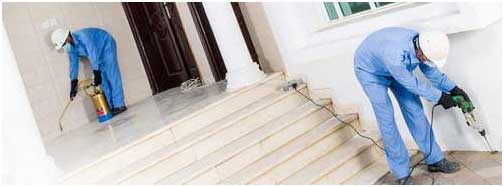
2. Treatment of External Perimeter : Drilling 12 mm. dia. Holes in the external perimeter of the building i.e. along the external wall surface of the building 30 cms. Apart and deep enough to reach the soil, squirting chemical through these holes under pressure till refusal or a maximum up to 1 lit. of aqueous solution per hole.
3. Treatment at points of contact of woodwork: Drilling 6 mm. dia. Holes at the joinery of door/windows and masonry at suitable intervals and squirting chemical solution till refusal both inside and outside of the building.
4. All the termite runways shall be sprayed over and after 15 minutes, these shall be removed.
5. IF THERE IS THE INFESTATION OCCURRED IN THE ELECTRICAL SWITCHBOARDS, IT SHALL BE TREATED LIBERALLY WITH CHEMICAL DUST OR FUMIGANTS
The above treatment has no effect on Non – Subterranean termites which also destroy books, paper, precious records, files etc.
(B)Non- subterranean termite infestation treatment: Control measures consist of treatment to wooden installations and fixtures by spraying a special oil-based insecticidal/ flying wood damaging insect pests. We’ll be using a versatile chemical, latest research brand, Chlorpyriphos 20 EC oil based emulsion on wooden installations, papers, books, records, etc.
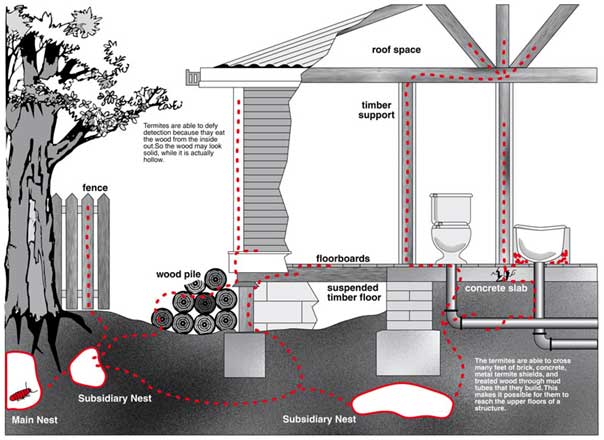
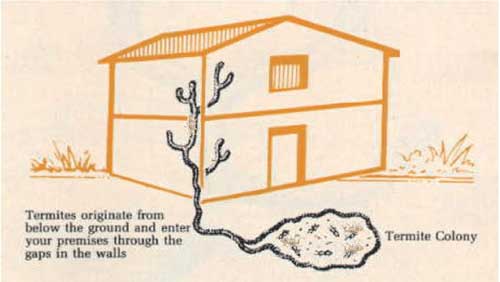
Whenever possible, it is best to treat a structure completely in accordance with the Structural Pest Control Rules. The North Carolina Official Waiver of Minimum Requirements for the Control of Subterranean Termites in Existing Structures is a standard form prescribed by the NC Structural Pest Control Committee. This form permits the licensee to deviate from or omit one or more of the minimum subterranean treatment requirements. For example, a waiver may be necessary because the working clearance in the crawlspace is inadequate for it to be treated properly, or a treatment requires indoor drilling that may not be desirable.
This latter situation usually occurs with slab construction, where holes must be drilled through the floor or the floor must be removed in order to drill the slab and treat the soil beneath it. Any part of the treatment that is waived must be properly explained on the standard waiver form. The waiver form is not required for termite baits/monitoring systems as long as the pest control company provides a service agreement and/or warranty for the entire structure treated.
Conclusion
Remember the best method for the control of subterranean termites is prevention. Listed below are some options that should be used in termite control.
Preventive measures should include:
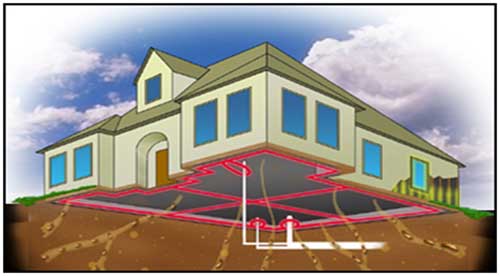
Anti Termites Pipe Network is a very cost effective method and is a revolutionary concept for Anti-Termite Treatment. No one is unaware of the destruction caused by the termites. Termites are a real problem and they create havoc to our wooden furniture, walls and wherever they have formed swarms. It has become our chief priority to save our sweet home. This System is a new concept in the area of pest control treatment for control of termites, developed by us for the permanent Solution of termites control.
It is a unique method of filling the chemicals through the already laid pipelines. which will prevent the structure as well as furniture, wooden fixtures from termites attack. This pipe is laid during construction of house before the flooring. Pipes are laid on the Joints of the internal wall and floor. Same kind of treatment will be done to the external perimeter also.

The job, which will be completed at flooring level, will be tested in your presence and the duly completed infrastructure will be handed over to you by creating The Refilling Points, which could be opened, used for periodic filling of pesticides in future. Infrastructure Installation is a very cost effective method of treatment and is a new milestone revolutionary concept as far as anti-termite treatment is concerned.
The advantages of this treatment are as under: